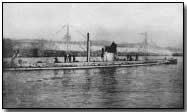Encyclopedia - The Otranto Barrage
 The Otranto Barrage,
designed by the Allies to prevent access by enemy submarines to the
Mediterranean via the Adriatic, proved as much of a failure as the
Northern Barrage
which was subsequently established in the North Sea. Both were
intended to prove as successful as the
Dover Barrage,
which was itself at best variable in its ability to impede enemy U-boat
access.
The Otranto Barrage,
designed by the Allies to prevent access by enemy submarines to the
Mediterranean via the Adriatic, proved as much of a failure as the
Northern Barrage
which was subsequently established in the North Sea. Both were
intended to prove as successful as the
Dover Barrage,
which was itself at best variable in its ability to impede enemy U-boat
access.
Work on the barrage began in the autumn of 1915 and comprised a fleet of some 60 British trawlers - of which only around 20 were ever in use at any one time - deployed in a line stretching south-east some 100km across from Brindisi in Italy to Corfu on the Albanian coast.
Each trawler carried a series of so-called light steel indicator nets anchored to the sea bed at various depths and used to effectively capture enemy submarines by entanglement. British warships and aircraft patrolled either end of the 100km line.
Almost from the start the Otranto Barrage lacked sufficient anti-submarine resources as priorities elsewhere in the Mediterranean led to the diversion of manpower and materials. This resulted in clear gaps in the line through which German and Austrian U-boats, based at Cattaro, could (and did) slip.
Inexplicably the British continued to regard the Otranto Barrage as an effective deterrent to enemy submarines. In part this was because, as at Dover, unexplained enemy losses were typically (and incorrectly) put down to the barrage's defences. Only one submarine, the Austrian U-6, was in fact verifiably caught by the indicator nets in the the Barrage's first two years.
By this time trawler casualties - incurred during night-time Austrian raids, notably during the Battle of the Otranto Straits when three destroyers and two cruisers sank 14 patrol craft and severely damaged an Italian supply convoy - led the Allies to effectively abandon night patrols. The Italian naval Commander-in-Chief regarded the Otranto Barrage as essentially indefensible.
The subsequent provision of U.S. Navy trawlers in 1918 to bolster the number of trawlers across the line was designed to increase the barrage's efficiency; nevertheless enemy submarines continued to slip through.
A 'Gearsman' was a tank crew member responsible for managing the gears.
- Did you know?
